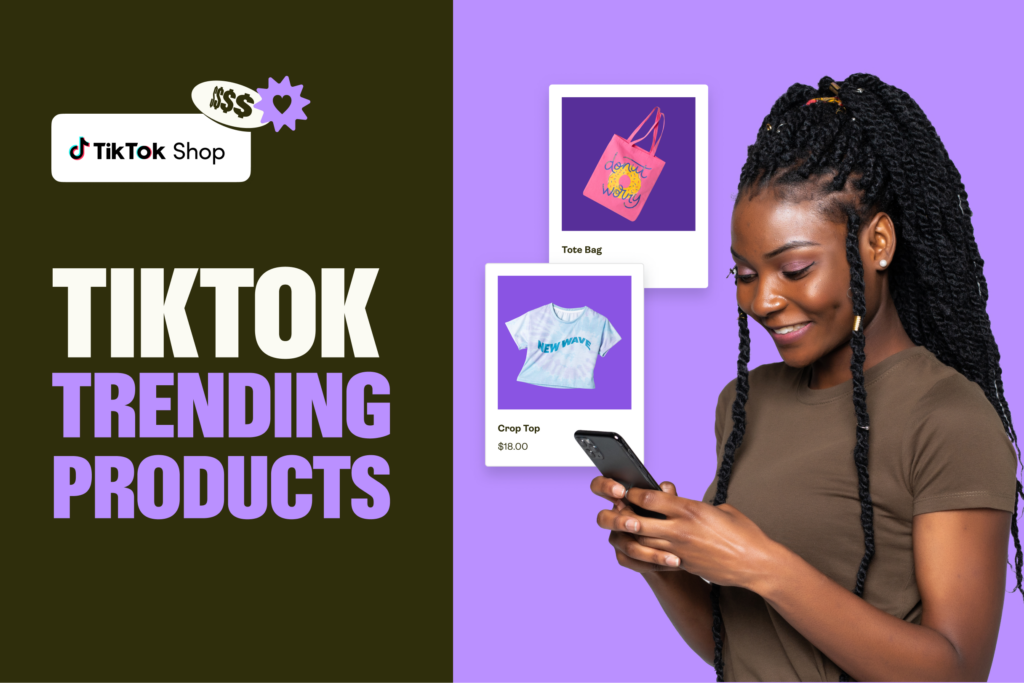Sell custom products with Printify
Our world is becoming more digital by the day, opening new entrepreneurial opportunities. Whether you’re a seasoned business owner or a first-time creator, selling digital products offers a flexible, scalable way to generate passive income.
This guide covers everything you need to know about creating, selling, and marketing the most profitable digital products in 2026, from online courses to Etsy downloads and resume templates – helping you build a sustainable, thriving business.
This post may contain affiliate links, which means we may earn a commission if you make a purchase through those links. This comes at no additional cost to you.
What is a digital product?
A digital product is any intangible item or piece of media that can be sold and delivered electronically. Unlike physical products, digital products don’t require inventory, packaging, or shipping, making them a cost-effective and scalable option for entrepreneurs looking to start or grow an online business.
Key features of digital products:
- Delivered online: Digital products are instantly accessible through downloads, links, or cloud-based storage. Some examples include instruction PDFs, online courses, and website templates.
- Scalable: A digital product can be sold repeatedly without additional production costs, making it ideal for generating passive income.
- Customizable: Many digital products, such as planners or CV templates, can be tailored to potential customers’ specific requirements.
- Broad selection: The possibilities are endless, from royalty-free photography to software services.
Examples of digital products
- Educational materials: Online courses, eBooks, and digital workshops that teach users new skills.
- Creative content: Digital art, stock photos, and digital planners designed for personal or commercial use.
- Tools and resources: Website templates, plugins, and marketing materials to help businesses thrive.
- Subscriptions: Access to exclusive content, communities, or software services online through monthly or yearly subscriptions.
Why digital products are popular
Consumers value digital products because they provide instant gratification, easy customization, and practical solutions that can be accessed anytime and anywhere. This makes them a profitable option for anyone looking to build a successful eCommerce business.
Why sell digital products?

Selling digital products has become a game-changer for entrepreneurs, freelancers, and creators for many reasons.
Low startup costs
Creating and selling your own digital products requires less investment than selling physical products. You don’t need to worry about inventory, storage, or shipping fees. All it takes is skill and a few inexpensive tools to start creating digital goods and selling them on online marketplaces or your own website.
Scalability
Digital products can be sold forever without additional production costs. Whether it’s a digital course, stock photos, or web templates, the same product can generate passive income repeatedly, making it a scalable and profitable business model.
Flexibility
Selling digital products online lets you work from anywhere. Whether designing online art, creating resume templates, or Etsy digital downloads of knitting patterns, you get to set your schedule and grow your business at your own pace.
High profit margins
Electronic product sales have much higher profit margins because no physical production or shipping is involved. Platforms such as Etsy and Shopify make listing digital planners or downloads simple.
Global reach
Digital products can be sold to anyone, anywhere. Whether targeting a niche audience with exclusive content or appealing to a larger market with more generic digital products, the Internet lets you reach millions of potential customers.
Growing demand
Consumers increasingly seek digital services and downloads, such as online courses or business tools. As a result, well-made digital products have excellent potential for long-term success.
Unlimited creative opportunities
From digital art and stock video to website themes and templates, the possibilities for creating and selling files in digital product marketplaces are virtually limitless. Whatever your skill set or passion, there is a way to turn it into a business.
Selling digital products in 2026 is an excellent way to build a sustainable, flexible, and rewarding business online.
How to find or create a digital product to sell

Creating a successful digital product starts with understanding your audience’s needs, aligning your skills with market demand, and choosing the right tools. Whether creating digital calendars, selling software, or providing learning tools, the key is adding value to your target audience.
Follow these steps to confidently create profitable digital products that resonate with your target audience and stand out from the competition.
1. Identify market demand
Before creating a digital product to sell online, research what is popular and what people are searching for.
Use platforms like Google Trends, Etsy, and Amazon to identify trending digital products. Search social media for current topics, pain points, or questions in your niche.
Read reviews of other digital products to see what customers like and their unmet needs. If you’re already running a business online, ask your audience what resources or tools they need most and how you could improve your existing products.
2. Assess your skills and resources
Choose a digital product relevant to your expertise and interests to increase your success in selling your product.
If you are an artist, sell virtual art or stock photography. Writers might prefer eBooks or publications.
If you’re a developer, create software, plugins, and web templates. Designers can create resume templates, digital advertising materials, or online learning tools.
3. Explore tools to simplify the process
There are many resources to help you start creating digital products:
For graphic design, use tools like Canva or Adobe Illustrator to design digital templates and printable files.
If offering educational digital products, platforms such as Teachable and Thinkific make creating and selling online courses easier.
Photographers and videographers will benefit from tools like Lightroom and Final Cut Pro for creating stock photos and videos.
4. Prototyping and testing
Before you start selling digital products, create a simple version and test it with a small group of potential customers.
Request feedback on usability, design, or pricing, then improve your product based on that information before releasing it to a larger audience.
5. Collaborate with experts
If you lack specific skills, consider outsourcing parts of the project.
Websites such as Fiverr and Upwork connect you with designers, developers, and editors who can help you create digital products that sell. Consider teaming up with other digital creators to offer bundled digital products that provide maximum value to your customers.
6. Prioritize value
Your digital product should solve a problem, fill a gap, or offer something unique.
Stay relevant by addressing your target audience’s needs and preferences, and always provide polished, professional products.
Have a simple download delivery system through your website, Etsy shop, or other online marketplace.
20 Digital products to sell in 2026
Here’s a detailed list of the top digital products to sell in 2026.
1. Online courses
Create structured learning modules to share your knowledge or expertise with your audience, like crochet tutorials or test prep materials.
2. eBooks
Write and design downloadable books about a specific topic or area of expertise, like self-help books or fan fiction novels.
- Pros: Low production costs, easy distribution, and excellent for demonstrating expertise.
- Cons: High competition, requires strong writing and design skills.
- Where to sell: Amazon Kindle Direct Publishing, Gumroad, Etsy, or start your own online store.
3. Digital templates

Create reusable templates for resumes, presentations, planners, and other business documents.
- Pros: Highly versatile, appeals to both individuals and businesses and has passive income potential.
- Cons: Design-heavy, potential for oversaturation in specific niches.
- Where to sell: Canva Marketplace, Creative Market, Etsy, or Shopify.
4. Stock photography
Sell high-quality photographs for marketing, websites, and media projects, like generic landscape, food, and animal photos.
- Pros: Continuous demand and scalable revenue.
- Cons: Requires high-quality equipment and skills, tough competition.
- Where to sell: Shutterstock, Adobe Stock, Alamy, or your website.
5. Stock videos
Provide video clips for creators, brands, and media companies requiring high-quality footage of cityscapes, nature, and more.
- Pros: Growing demand and potential for recurring income.
- Cons: Time-consuming to create and requires editing expertise.
- Where to sell: Pond5, Shutterstock, iStock, or Artgrid.
6. Music and audio files
Sell beats, sound effects, jingles, and voiceovers for creators and film producers.
- Pros: Perfect for musicians and sound designers, reusable across multiple projects.
- Cons: Niche-specific demand and may require technical expertise.
- Where to sell: AudioJungle, Bandcamp, or Fiverr.
7. Printables

Design downloadable products like day planners, calendars, and activity or coloring sheets for kids.
- Pros: Simple to create and consistently some of the best-selling digital products.
- Cons: Requires good design sense and effective marketing strategies.
- Where to sell: Etsy, Creative Market, or Gumroad.
Printify lets you go beyond creating digital planners to offering print-on-demand physical planners, providing your customers with both digital and tangible options. This flexibility can increase your sales and expand your reach.
8. Website templates
Develop ready-made designs for websites, blogs, or online stores, like profile banners, product page layouts, and more.
- Pros: Evergreen demand, very profitable for developers and designers.
- Cons: Requires coding or design expertise, time-intensive to create.
- Where to sell: ThemeForest, TemplateMonster, or your website.
9. Plugins and widgets
Create functional add-ons for websites or software that improve usability, like chatbots, contact forms, and popups.
- Pros: High utility and potential for recurring sales.
- Cons: Requires advanced programming skills and regular updates.
- Where to sell: CodeCanyon, GitHub, or your online store.
10. Digital art

Sell unique artwork in digital formats for personal or commercial use. Digital art has infinite possibilities, which is why it is such a profitable digital product. Digitize your comics, drawings, paintings, and more to give buyers instant access to their new art.
- Pros: Perfect for artists, customizable
- Cons: Requires advanced design skills and tools, demand can be subjective.
- Where to sell: Etsy, ArtStation, or Gumroad.
11. NFTs (Non-fungible tokens)
An NFT is like a one-of-a-kind receipt stating that you own something online. Sell digital products like art, collectibles, gaming assets, and more as NFTs to those who prefer a slightly different approach to owning digital content.
12. Audiobooks
Create and narrate audiobooks on whatever topic you’re knowledgeable and passionate about.
- Pros: Complements eBooks, growing demand.
- Cons: Time-intensive production and requires strong narration skills.
- Where to sell: Audible, Google Play Books, or your website.
13. Digital marketing tools
Offer tools like social media schedulers or analytics dashboards to appeal to social media managers and content creators.
- Pros: High demand, recurring revenue potential.
- Cons: Complex to develop and requires ongoing maintenance.
- Where to sell: Shopify App Store, Gumroad, or software directories.
14. Language learning resources
Provide resources such as flashcards, audio lessons, and grammar guides for adults looking to brush up their knowledge on topics like history and science or for kids who need extra help outside the classroom.
15. Data sets and market reports
Sell research-based insights tailored to specific industries or markets, like dada-driven trend predictions for customer behavior in a particular market.
17. Fitness or meal plans
Offer tailored fitness routines or meal plans for health-conscious audiences, such as those looking to lose a few pounds or build muscle for a bodybuilding competition.
18. Subscription-based digital content
To supplement your public-facing content, provide exclusive content through a monthly or yearly subscription, such as podcasts, tutorials, and more.
19. Digital communities
Create private groups or forums for knowledge sharing or networking, like online meetups for small business owners to network and support one another.
- Pros: Builds a loyal audience and encourages engagement.
- Cons: Requires active moderation and management.
- Where to sell: Discord, Mighty Networks, or social media groups.
20. Digital publications
Sell subscription-based newsletters, magazines, or niche reports on topics like cooking or parenting.
- Pros: Great for writers and researchers, flexible topics.
- Cons: Demands consistent, high-quality content.
- Where to sell: Medium, Gumroad, or your online store.
With these 20 digital product ideas and actionable tips, you’re ready to find what best fits your expertise and market demand.
How to sell digital products

Selling digital files requires a combination of the right platforms, effective delivery systems, and strategic marketing strategy to reach your target audience. Here’s a step-by-step guide to help you maximize your sales.
1. Choose the right platform
Your platform determines how customers access your electronic goods. Choose one based on your product type, target market, and business objectives.
- Marketplaces:
- Etsy: Ideal for digital printables, planners, and CV templates.
- Creative Market: Best for web templates, digital assets, and art.
- Shutterstock/iStock: Perfect for stock photography and stock video.
- Gumroad: A user-friendly option for selling digital downloads and exclusive content.
- eCommerce platforms:
- Shopify: Great for creating a professional online store for all digital products.
- Wix: Comes with tons of website templates to make setup easy.
- Website builders:
- Use platforms like WordPress or Squarespace to build your website for total control over branding and sales.
- Use platforms like WordPress or Squarespace to build your website for total control over branding and sales.
- Niche platforms:
- Thinkific and Teachable: Ideal for selling online learning tools.
- Patreon and Substack: Best for subscription-based online communities and newsletters.
2. Perfect your delivery process
While digital products do not require shipping, you will still give them to your customers electronically. Seamless digital product delivery builds trust and keeps customers satisfied.
- Automated delivery: Use tools like SendOwl to send emails with links to download the digital products immediately after purchase.
- Membership access: Provide clear instructions on accessing subscription-based content, like login information for your site.
- Cloud storage: Services like Google Drive or Dropbox are excellent for secure file sharing, especially for large downloads such as stock videos or website templates.
3. Create an effective pricing strategy
Your digital products’ pricing can make or break your sales. Set your prices too low, and you won’t make a profit. If you set them too high, customers will run the other way.
- Understand your audience: Consider your potential customers’ budget.
- Value-based pricing: Highlight your digital products’ unique benefits and convenience, increasing their perceived value.
- Offer tiered pricing: Create packages for digital services or courses (e.g., basic and premium content) to appeal to a wider audience.
- Discounts and bundles: Combine related digital items into bundles for higher sales.
4. Optimize for search engines
Search Engine Optimization (SEO) is the process of including relevant keywords, images, and information in your product listings to help them appear high in search results.
- Keyword placement: Use terms related to your product and its benefits in the titles and descriptions.
- Meta descriptions: Craft compelling snippets that appear below your link in search results to attract more clicks.
- Image optimization: Include descriptive alt text for your digital art or stock photos to make them more visible in search results.
- Content marketing: Write blogs about your digital product types and related industries and include links to your store.
5. Take advantage of social media channels.
These days, many people get shopping inspiration and product recommendations on social media. Build a presence there to improve your reach and visibility for your target audience.
- Instagram: Highlight visual products such as digital printables and art.
- TikTok: Use short videos to demonstrate your product’s value or behind-the-scenes creation.
- Facebook groups: Build communities around your niche and share your digital products there.
- LinkedIn: Promote digital products that are especially useful to professionals, such as CV templates or online courses on acing job interviews.
6. Build an email marketing strategy
Email campaigns are a powerful way to nurture leads and retain customers, so developing an effective email marketing strategy can be extremely beneficial for your online business.
- Welcome series: Send a sequence of emails introducing your brand and products.
- Exclusive offers: Provide discounts or early access to new products.
- Educational content: Share tips, case studies, or tutorials related to your niche to establish authority.
7. Use paid advertising
If your budget allows, invest in paid ads to reach a broader audience and boost sales.
- Google Ads: Target keywords related to your niche. Use Google Trends or eRank to see which terms have a high search volume.
- Facebook and Instagram Ads: Create visually appealing ads to promote your digital products.
- Pinterest Ads: Create Pins of your products to reach those looking for inspiration for things like digital planners and templates. Ensure the Pins link to your website.
8. Provide great customer support
Having exceptional customer support builds trust and encourages repeat purchases.
- FAQs: Anticipate and answer common questions about your digital products on a dedicated page.
- Sneak peeks: Offer customers samples of your product so they can preview it before purchasing. This builds trust and helps shoppers determine whether your product is right for them.
- Live chat: Use tools like Zendesk to assist customers in real time.
- After-sales engagement: Send follow-ups to ensure satisfaction and recommend related products.
9. Ask for reviews and testimonials
Social proof can significantly influence buying decisions for on-the-fence shoppers. Seeing that others have enjoyed your product might be just what someone needs to click Buy Now.
- Request feedback: Ask satisfied customers to leave product reviews.
- Highlight success stories: Showcase testimonials of how others benefited from your digital offerings.
- Incentivize reviews: Offer small discounts or additional content for honest feedback.
Future trends in digital products

Staying ahead of the curve is critical to success when you sell digital products online.
Staying innovative, anticipating consumer needs, and adapting to emerging technologies will keep you competitive and profitable in the ever-changing digital product sales landscape.
Here are the top trends influencing the digital product market in 2025 and how to capitalize on them.
AI-generated content
Artificial intelligence is taking our world by storm. Use it to your advantage when creating digital products.
Tools like ChatGPT, DALL·E, and Canva’s AI features can help you develop high-quality content faster than ever. This saves you time and brain power when making new templates, writing an online course, or creating marketing materials to post on your social media accounts.
Virtual and augmented reality (VR/AR)
Immersive experiences are gaining popularity across industries.
Create and sell digital products like 3D assets for VR, such as textures, environments, and objects. To appeal to a new audience, turn your online courses into VR games to make learning much more fun. Develop AR filters for social media apps like Snapchat, Instagram, and TikTok.
Subscription-based models
Customers feel they’re getting a great deal when they purchase access to premium content or software for months or years.
Sell subscription packages for digital services like exclusive newsletters, video courses, and audio content like podcasts. Offer options to pay for three, six, or even 12 months at once for a slight discount.
Sustainability and ethical marketing
Many consumers prioritize environmentally conscious and ethical products and are willing to pay more for these items and services.
In your marketing, emphasize the eco-friendliness of virtual goods over physical products. Highlight the waste reduction achieved by choosing digital downloads, like PDF files of sewing patterns or eBooks, over paper versions that require shipping.
Personalization
Personalized products are becoming an important differentiator in competitive markets. Consumers want products tailored to their unique needs, from customizable CV templates to personalized digital calendars.
Include personalization options in your sales strategy. For example, let customers personalize the website themes or branding kits with their own colors and text.
Microlearning
Bite-sized learning modules are in high demand among busy professionals and students. Gone are the days when people were willing to sit through lengthy online courses – they want short, focused lessons they can consume on the go.
To meet this demand, break down your online course into modular lessons and market them as quick solutions for skill development.
Community-driven digital products
Buyers value connection and collaboration, which has led to the rise of product-specific digital communities.
Pair your digital products with access to private groups or forums on Discord or Mighty Networks. This will open the door to community support and networking, increasing the overall value of your products.
Optimized user experience (UX)
Consumers increasingly prioritize simplicity, easy-to-use interfaces, seamless navigation, and immediate access to digital items.
Invest in tools and platforms that improve the delivery and usability of your digital products, such as user-friendly storefronts or automated shipping systems.
NFTs and blockchain integration
NFTs are no longer limited to art – they can be used for memberships, certifications, and extra content access.
Explore this unique solution for selling unique or exclusive digital products, such as collectible digital art or VIP event access.
Video-centric products
Video is one of the most engaging digital formats. From stock videos for marketing to video-based learning, consumers are demanding more dynamic content.
Create virtual projects for marketers and educators, such as tutorials and video asset templates.
Final thoughts on digital products to sell in 2026
The digital product industry is full of opportunities, and 2025 will be a year of tremendous growth. Whether you’re an experienced entrepreneur or a newcomer looking for digital product ideas, the possibilities are limitless.
Build a profitable business by focusing on the right digital products to sell online, such as video courses, art, and printables. Use the right sales platforms and marketing techniques and stay ahead of trends to sell digital products successfully.
Not sure where to start? Look into selling digital planners with Printify! It’s fast, easy, and requires no upfront costs, making this one of the best digital products to sell.













